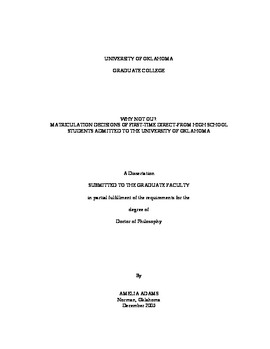| dc.contributor.advisor | DeBacker, Teresa, | en_US |
| dc.contributor.author | Adams, Amelia. | en_US |
| dc.date.accessioned | 2013-08-16T12:20:18Z | |
| dc.date.available | 2013-08-16T12:20:18Z | |
| dc.date.issued | 2006 | en_US |
| dc.identifier.uri | https://hdl.handle.net/11244/1056 | |
| dc.description.abstract | In addition, the primary theme of this dissertation---enrollment choice--- involves issues related to decision-making by both the student and the institution. Decision-making is a fundamental component of the leadership equation. Thus, this dissertation indirectly examines how future leaders---students---make major decisions that may affect their future; how current leaders---academic administrators---make decisions that may affect the institution's future; and how the interaction of both students and administrators influences the choices of each. | en_US |
| dc.description.abstract | This research project examined why undergraduate students who have applied and been admitted to the University of Oklahoma (OU), chose not to attend OU. It contributes to the growing body of literature in higher education that examines the college selection process, enrollment management policies and procedures, undergraduate recruiting practices, and undergraduate admission policies. Literature in these areas can be divided into two categories: research studies from the student perspective (college choice) and research studies from the academic institutions perspective (enrollment management). | en_US |
| dc.description.abstract | Based on data collected and analyzed from all first-time direct-from high school students admitted to OU for the Fall 2005 semester, and the data collected and analyzed from a sub-sample of these students, seven categories of potential enrollment choice action areas were identified and discussed. These included: People---the demographic differences between students who chose to attend OU and those who did not; Choice---the selection policies and procedures the University uses in order to admit the desired student population; Market---the geographic regions that contain students most interested in attending OU; Competitors---the other schools these students consider in addition to OU; Money---the financial concerns of the desired student population; Communication---the ways in which the University interacts with the desired student population; and Perception---the intended and unintended image the institution projects about itself. | en_US |
| dc.format.extent | xix, 242 leaves : | en_US |
| dc.subject | Education, Higher. | en_US |
| dc.subject | College choice Case studies. | en_US |
| dc.subject | University of Oklahoma Admission. | en_US |
| dc.subject | College choice Oklahoma. | en_US |
| dc.title | Why not OU? Matriculation decisions of first-time direct-from-high-school students admitted to the University of Oklahoma. | en_US |
| dc.type | Thesis | en_US |
| dc.thesis.degree | Ph.D. | en_US |
| dc.thesis.degreeDiscipline | Department of Educational Psychology | en_US |
| dc.note | Source: Dissertation Abstracts International, Volume: 67-04, Section: A, page: 1238. | en_US |
| dc.note | Adviser: Teresa DeBacker. | en_US |
| ou.identifier | (UMI)AAI3218213 | en_US |
| ou.group | Jeannine Rainbolt College of Education::Department of Educational Psychology | |
